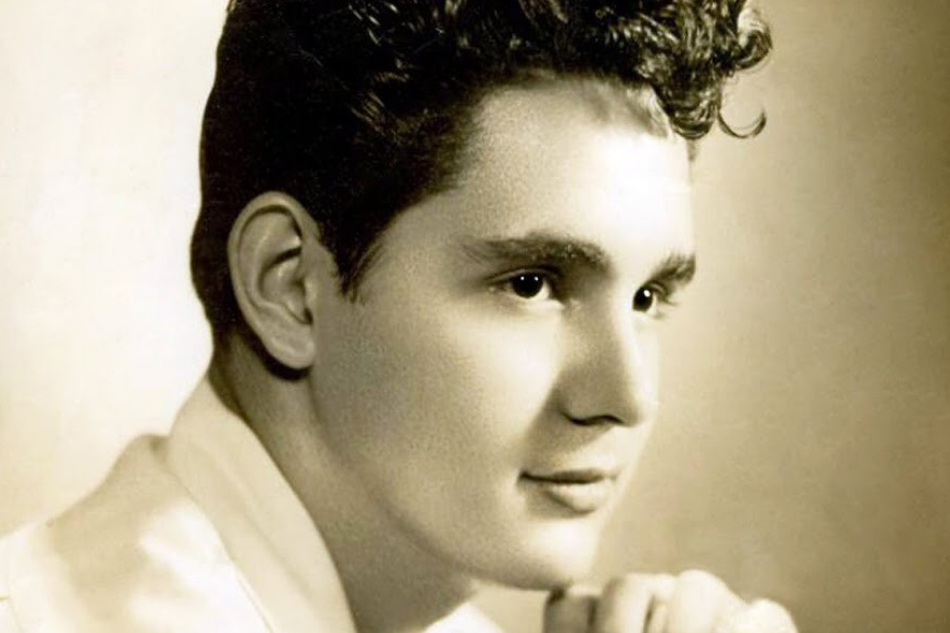His movies hark back to more innocent times—Baby Face, Handsome, and Amy, Susie and Tessie among them—when filmgoers swooned over, well, baby-faced leading men and pretty and demure leading ladies. Jose Mari Gonzales was among the icons of Philippine cinema’s studio era, when Spanish and American mestizos lit up the silver screen like gods and goddesses from Olympus.
Gonzales was at the height of his movie star fame in the late 50s and early 60s. He was part of a group of young men and women who possessed classically beautiful faces, wavy, light brown hair, statuesque heights, fair complexions, and proficiency in the Spanish and English languages. Jose Mari was among the most sought-after matinee idols of the era. Handsome, mestizo, educated, and de buena familia, he was the embodiment of the niño bonito dreamboat peddled by the movie studios.
Born July 1938, Jose Mari was the eldest of seven children of Roque Ma. Gallegos Gonzalez of Cebu and Carmen Orozco Chacarrategui of Mauban, Quezon, both born July 15, 1910. He had four brothers—Ramon, Roque, Jr. “Chiqui,” Luis+, and Francisco “Paco”—and two sisters, Marilou Gonzalez Joaquin and Connie Gonzalez Araneta.
In 1945, his father founded ROMAGO Electric Co., Inc. a company which dealt with electromechanical system engineering and installation services, now known as ROMAGO, Inc. and run by his brother, Francisco. He went to Colegio de San Juan de Letran for his grade school and high school education, later transferring to De La Salle College Taft for his college education. Thereafter, he enrolled in the distance learning program of the Cleveland Institute of Electronics Broadcast Engineering, earning a degree in Broadcast Engineering, and then at Grantham School of Electronics (later Grantham College of Engineering) where he took a home study course on Electronics Engineering.
While appearing as a commercial model for print ads in the late 1950s, Mrs. Azucena Vera-Perez, wife of Dr. Jose Perez of Vera-Perez Productions, sister company of Sampaguita Pictures, took notice of him and offered him a movie contract. He was introduced in Mar S. Torres’ Palaboy (1958) with co-stars, Gloria Romero and Luis Gonzales, followed by Tony Cayado’s Tawag ng Tanghalan (1958), Jose de Villa’s Ulilang Anghel (1958), and Mar S. Torres’ Mga Anghel sa Lansangan (1959). He achieved stardom in Carlos Vander Tolosa’s Baby Face (1959) with Amalia Fuentes, and Handsome (1959) with Susan Roces.
His star continued to rise in the early 1960s with a succession of movies for his home studio, Sampaguita Pictures. Among these movies were Beatnik (1960) with Susan Roces; 7 Amores (1960) with Susan Roces; Amy, Susie, & Tessie (1960) with Amalia Fuentes, Susan Roces and Tessie Agana; Armando Garces’ Operetang Sampay Bakod (1961) with Amalia Fuentes and Dolphy; The Big Broadcast (1962), a musical with an all-star cast; Dance-O-Rama (1963) with Susan Roces; and the comedy, Amaliang Mali-Mali vs. Susanang Daldal (1963).
Perhaps inspired by Billy Wilder’s comedy classic, Some Like it Hot (1959) starring Tony Curtis and Jack Lemmon as cross-dressing musicians, Jose Mari starred in two cross-dressing movies, Mar S. Torres’ Joey, Eddie, and Lito (1961) with Eddie Gutierrez, Lito Legaspi, Amalia Fuentes, Susan Roces, and Liberty Ilagan, and Tony Cayado’s Kaming Mga Talyada (1962) with the special appearance of Miss Christine Jorgensen, an American trans woman actress who was the first widely known person to have a sex change operation in the U.S.
After a succession of movies with Amalia and Susan (the Amy and Susy in the abovementioned flick, if you don’t know your ‘60s cinema) as leading ladies, he began to be paired with his then girlfriend, Liberty Ilagan, daughter of National Artist for Film Gerry de Leon and actress Fely Vallejo. Among the movies they made were Carlos Vander Tolosa’s Lover Boy (1958) with Romeo Vasquez and Susan Roces; Tindahan ni Aling Epang (1961); Sweet Valentines (1962); and Lauro Pacheco’s I Miss You So (1965) which was produced by Larry Santiago Productions.
After achieving stardom in a succession of movies, Jose Mari Gonzalez married the beautiful Charito Malarky in 1964 and they had five children: former actress and now Tacloban City Mayor Cristina Gonzalez Romualdez, Jose Luis, Michael, Ana Margarita, and Jose Mari, Jr.
Apart from acting, Gonzales was into music. He founded the Electromaniacs Band in 1960, established the then state-of-the-art Cinema-Audio recording studio and became an officer of the Resources Management Group, the Philippine Recording Industry Association, Rainbow Communications Organization, and the Philippine Amateur Radio Association. He was made Director of the Bureau of Broadcast during the term of President Corazon Aquino and in 1994 headed RPN 9 where he started the trend of dubbing Spanish language teleseryes like Marimar in Filipino, to great success.
Like many actors in the country, Gonzales was lured by politics later on and last caught the spotlight as the San Juan rep who “slapped”—Gonzales would later on say it was actually a karate chop—former House of Representatives sergeant-at-arms Bayani Fabic during the height of the impeachment deliberations for then President Joseph Estrada.
He ran and won as Congressman of San Juan in 1998 but his political career was cut short after he got involved in the abovementioned incident in November of 2000. He then retired from public life and recently relocated from his former residence in San Juan City to Alabang Hills, Muntinlupa City.
Jose Mari passed away at age 80 at the Asian Hospital & Medical Center at 6:30 AM, April 16, 2019 after suffering from pneumonia and cardiac arrest. He is survived by his wife, Charito, and five children. He is remembered dearly by his family, friends, showbiz colleagues, and fans with the outpouring of posts mourning his sudden passing—messages accompanied by vintage photographs of local cinema’s original Baby Face.

